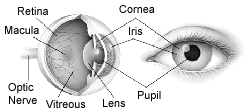< Page 5 of 13 >
1 2 3 4 5 6 7 8 9 10 11 12 13
Color
Vision
Color Perception Factors
Physiological Factors
The physiological factors that affect color perception deal with color vision deficiencies often referred to as color blindness. Color vision deficiencies occur in less than 9% of the population -- 8% of which are male and approximately 0.5% females. More on the specific color vision anomalies is covered later in this course.
When light is reflected off an object and passes into the eye, the iris regulates the amount of light that flows through the lens to the retina. The lens focuses the light onto the retina based on its wavelength.
 The
retina is to the eye what film is to a camera. It is a complex nerve
structure containing millions of light-sensitive receptors that are
responsible for translating incoming light into nerve impulses. Because
of their physical appearance these receptors are known as rods and cones.
The
retina is to the eye what film is to a camera. It is a complex nerve
structure containing millions of light-sensitive receptors that are
responsible for translating incoming light into nerve impulses. Because
of their physical appearance these receptors are known as rods and cones.
Rods function in low or dim light and are responsible for low light or night vision. The rods in the retina are sensitive to a broad range of light intensities but do not distinguish color. Cones function in daylight and contain light-sensitive chemicals called photopigments. These photopigments contribute to color sensation. Each cone has one of three types of photopigments, which are informally named red, green, and blue. They are named after the wavelengths to which they are sensitive.
From the retina, the information from the rods and cones is transmitted along the optic nerve to the brain. What the brain sees is the experience of the viewer and the condition of the rods and cones on the retina. If some are diseased, the viewer's interpretation of certain colors will be affected, and color blindness may result. If the rods are diseased, the result will be night blindness. Some individuals are born with color vision anomalies. Color vision can also affected by age, fatigue, as well as general health.
Although some people may have better color discrimination abilities than others, for a person engaged in certain occupations where accurate color perception is critical, such as the graphic arts, it takes more than just a good eye for accurate color evaluation. No matter how well trained, a person's eyes can be easily overwhelmed by factors that can contribute to the apparent color of an image. These factors include the amount and quality of light illuminating the image, and the color of the background against which the image is viewed.
< Page 5 of 13 >
1 2 3 4 5 6 7 8 9 10 11 12 13